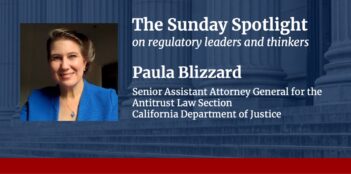
As the scope of regulation in an industry narrows, the scope of potential antitrust liability becomes broader.
Antitrust law is a residual regulator, picking up where legislative regulation leaves off. The relationship between antitrust law and regulation at any given time depends on perceptions about what a regulatory regime leaves for the free market.
These issues arose following New Deal era expansions of federal regulation. The U.S. Supreme Court recognized an immunity from antitrust laws only if Congress expressly authorized it. That was the Court’s principal holding in its 1939 United States v. Borden decision, which involved the Agricultural Marketing Agreement Act, and again in its 1945 Georgia v. Pennsylvania Railroad decision, which involved the Interstate Commerce Act. Neither statute expressly provided an antitrust immunity, and the Court found this conclusive.
In the 1960s, however, the Supreme Court began worrying that conflicts would emerge if antitrust laws were applied in situations where regulation was pervasive—that is, if a regulatory agency comprehensively controlled a firm’s market behavior. For example, in its 1963 Pan American World Airways v. United States decision, the Supreme Court found that the Civil Aeronautics Board had “broad jurisdiction” over the behavior of airlines. As a result, antitrust law had no authority to police airline cartels, even though the Federal Aviation Act said nothing about antitrust immunity. This doctrine came to be called “implied antitrust immunity.”
The Pan Am model was very optimistic about the efficacy and scope of regulation, envisioning it as a complete substitute for free market forces. The reality is quite different. Regulatory provisions never reach every competition-affecting thing that a regulated firm does. Within the Pan Am mindset that was regarded as a shortcoming, but today we are more likely to regard it as good and necessary. Given regulation’s poor track record in mimicking competitive behavior, perhaps the best approach is to regulate narrowly, only for proven market failure, and let the market and thus antitrust policy control the rest.
A competing line of thinking emerged that antitrust should fill regulatory gaps, of which there were many. For example, in United States v. Philadelphia National Bank, the Court held that, although banking regulators had the power to approve bank mergers, they did not evaluate competitive effects as antitrust law did. As a result, antitrust merger law could be applied to bank mergers. In the 1973 Otter Tail Power v. United States case, the government accused the defendant of refusing to wholesale, or “wheel,” power to other utilities. The then-existing Federal Power Commission controlled retail distribution but had no authority over wheeling. The Court responded that antitrust law should fill this gap.
These “gap-filling” decisions paved the way for today’s more “transactional” approach to the relationship between regulation and antitrust. Rather than considering regulation as a whole, the court should focus more narrowly on the challenged conduct. If the conduct was under the agency’s control and the agency was supervising it adequately rather than rubber-stamping anticompetitive behavior, then no room remained for antitrust. “Even when an industry is regulated substantially,” the Supreme Court concluded in 1981, that does not entail “an intent to repeal the antitrust laws with respect to every action…taken within the industry.” Rather, immunity is called for “when a regulatory agency has been empowered to authorize or require the type of conduct under antitrust challenge.”
One consequence of deregulation since the 1980s has been the gradual expansion of antitrust law to fill the expanding amount of empty regulatory space. For example, the airlines, once declared immune from the antitrust laws, are readily subject to them today.
Within this framework, it is not antitrust’s purpose to “fix” regulation. Even if a regulation reflects industry capture at consumers’ expense, antitrust can do no more than follow the regulatory mandate. What it can do, however, is ensure that a challenged action is really “regulated,” meaning that it has been authorized and reviewed by governmental actors and is not an act of unsupervised private discretion. This approach also explains why antitrust law’s petitioning immunity protects from antitrust attack people who lobby the government for or against regulations in ways that might serve private interests rather than those of the public.
These same principles guide the relationship between federal antitrust law and state and local government regulation. The U.S. Constitution recognizes both the federal government and the states as sovereign. Each has regulatory authority within its own domain. But federal antitrust law reaches many local activities, including the learned professions, occupational licensing, land use, local public transportation, municipal services, and health and safety. The antitrust state action doctrine—not to be confused with Fourteenth Amendment state action—immunizes private conduct from the federal antitrust laws, but only if the state has clearly “authorized” a challenged practice and a government official reviews how the practice is implemented.
For example, in its North Carolina State Board of Dental Examiners v. Federal Trade Commission decision, the Supreme Court applied antitrust law to condemn the rule of a professional “agency” run entirely by practicing dentists that forbad non-dentists from whitening teeth commercially. This private group had absolute authority to enforce this rule, which was not supervised by any public official.
The state action doctrine is a distinctive product of federalism. It permits the state to regulate as it sees fit, provided that the state authorizes the conduct in question and the private conduct is sufficiently supervised by the government rather than a private group. That makes the transactional approach courts apply to state legislation very similar to the one applied to federal regulation.
This essay is part of an eight-part series, entitled Celebrating The Regulatory Review’s Tenth Anniversary.




